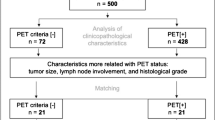Abstract
Objective
The objective of this study is to determine whether 2-deoxy-2-[18F] fluoro-d-glucose with positron emission tomography (FDG-PET) imaging and quantitative PET parameters can predict outcome and differentiate patients with limited disease (LD) from extensive disease (ED) in patients with small cell lung cancer (SCLC).
Methods
We retrospectively evaluated data from 25 patients who underwent either initial staging (Group A, n 12) or restaging (Group B, n 13) by conventional imaging methods and FDG-PET according to the simplified staging scheme developed by the Veterans Administration Lung Cancer Study Group-2. FDG-PET images were both visually and quantitatively evaluated with SUVmax, SUVave, total metabolic tumor volume (with SUVmax > %50 and SUVmax > 2.5), total lesion glycolysis (TLG) (with SUVmax > %50 and SUVmax > 2.5). The correlation between quantitative PET parameters, disease stages and survival were analyzed.
Results
By conventional methods 14 of 25 (56%) patients were reported to have LD and 11 of 25 (44%) had ED. FDG-PET scan upstaged 9 out of 25 (36%) and downstaged 2 out of 25 (%8) patients. Among the quantitative PET parameters, TLGs were the only PET parameters that differentiated between Group A and Group B patients. FDG-PET staging (p = 0.019) could predict significant survival difference between stages on contrary to conventional staging (p = 0.055). Moreover, TLG [SUVmax > %50] was the only quantitative PET parameter that could predict survival (p = 0.027).
Conclusion
FDG-PET imaging is a valuable tool in the management of patients with SCLC for a more accurate staging. The use of quantitative PET parameters may have a role in prediction of stage and survival.


Similar content being viewed by others
References
Jemal A, Siegel R, Ward E, Hao Y, Xu J, Thun MJ. Cancer statistics, 2009. CA Cancer J Clin. 2009;59:225–49.
Micke P, Faldum A, Metz T, Beeh KM, Bittinger F, Hengstler JG, et al. Staging small cell lung cancer: Veterans Administration Lung Study Group versus International Association for the Study of Lung Cancer—what limits limited disease? Lung Cancer. 2002;3:271–6.
Jackman DM, Johnson BE. Small-cell lung cancer. Lancet. 2005;9494:1385–96.
Rigo P, Paulus P, Kaschten BJ, Hustinx R, Bury T, Jerusalem G, et al. Oncological applications of positron emission tomography with fluorine-18 fluorodeoxyglucose. Eur J Nucl Med. 1996;12:1641–74.
Johnson BE, Crawford J, Downey RJ, Ettinger DS, Fossella F, Grecula JC, et al. Small cell lung cancer clinical practice guidelines in oncology. National Comprehensive Cancer Network (NCCN). J Natl Compr Canc Netw. 2006;6:602–22.
Podoloff DA, Ball DW, Ben-Josef E, Benson AB 3rd, Cohen SJ, Coleman RE, et al. NCCN task force: clinical utility of PET in a variety of tumor types. J Natl Compr Canc Netw. 2009;7(Supp 2):S1–26.
Arslan N, Miller TR, Dehdashti F, Battafarano RJ, Siegel BA. Evaluation of response to neoadjuvant therapy by quantitative 2-deoxy-2-[18F] fluoro-d-glucose with positron emission tomography in patients with esophageal cancer. Mol Imaging Biol. 2002;4:301–10.
Lin LL, Yang Z, Mutic S, Miller TR, Grigsby PW. FDG-PET imaging for the assessment of physiologic volume response during radiotherapy in cervix cancer. Int J Radiat Oncol Biol Phys. 2006;1:177–81.
Hoekstra CJ, Paglianiti I, Hoekstra OS, Smit EF, Postmus PE, Teule GJ, et al. Monitoring response to therapy in cancer using [18F]-2-fluoro-2-deoxy-d-glucose and positron emission tomography: an overview of different analytical methods. Eur J Nucl Med. 2000;6:731–43.
Brink I, Schumacher T, Mix M, Ruhland S, Stoelben E, Digel W, et al. Impact of [18F]FDG-PET on the primary staging of small-cell lung cancer. Eur J Nucl Med Mol Imaging. 2004;12:1614–20.
Blum R, MacManus MP, Rischin D, Michael M, Ball D, Hicks RJ. Impact of positron emission tomography on the management of patients with small-cell lung cancer: preliminary experience. Am J Clin Oncol. 2004;2:164–71.
Azad A, Chionh F, Scott AM, Lee ST, Berlangieri SU, White S, et al. High impact of (18)F-FDG-PET on management and prognostic stratification of newly diagnosed small cell lung cancer. Mol Imaging Biol. 2010;4:443–51.
Park HK, Jeon K, Koh WJ, Suh GY, Kim H, Kwon OJ, et al. Occult nodal metastasis in patients with non-small cell lung cancer at clinical stage IA by PET/CT. Respirology. 2010;8:1179–84.
Akhurst T, Ng VV, Larson SM, O’Donoghue JA, O’Neel J, Erdi Y, et al. Tumor burden assessment with positron emission tomography. Clin Positron Imaging. 2000;2:57–65.
Lee HY, Hyun SH, Lee KS, Kim BT, Kim J, Shim YM, et al. Volume-based parameter of (18) F-FDG PET/CT in malignant pleural mesothelioma: prediction of therapeutic response and prognostic implications. Ann Surg Oncol. 2010;10:2787–94.
Costelloe CM, Macapinlac HA, Madewell JE, Fitzgerald NE, Mawlawi OR, Rohren EM, et al. 18F-FDG PET/CT as an indicator of progression-free and overall survival in osteosarcoma. J Nucl Med. 2009;3:340–7.
Roedl JB, Colen RR, Holalkere NS, Fischman AJ, Choi NC, Blake MA. Adenocarcinomas of the esophagus: response to chemoradiotherapy is associated with decrease of metabolic tumor volume as measured on PET–CT. Comparison to histopathologic and clinical response evaluation. Radiother Oncol. 2008;3:278–86.
Benz MR, Allen-Auerbach MS, Eilber FC, Chen HJ, Dry S, Phelps ME, et al. Combined assessment of metabolic and volumetric changes for assessment of tumor response in patients with soft-tissue sarcomas. J Nucl Med. 2008;10:1579–84.
Lee P, Weerasuriya DK, Lavori PW, Quon A, Hara W, Maxim PG, et al. Metabolic tumor burden predicts for disease progression and death in lung cancer. Int J Radiat Oncol Biol Phys. 2007;2:328–33.
Author information
Authors and Affiliations
Corresponding author
Rights and permissions
About this article
Cite this article
Arslan, N., Tuncel, M., Kuzhan, O. et al. Evaluation of outcome prediction and disease extension by quantitative 2-deoxy-2-[18F] fluoro-d-glucose with positron emission tomography in patients with small cell lung cancer. Ann Nucl Med 25, 406–413 (2011). https://doi.org/10.1007/s12149-011-0478-y
Received:
Accepted:
Published:
Issue Date:
DOI: https://doi.org/10.1007/s12149-011-0478-y




